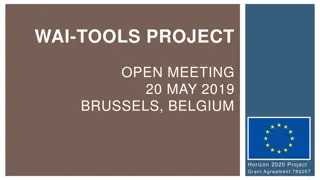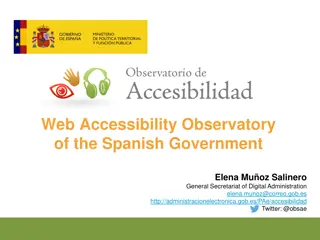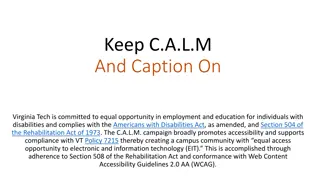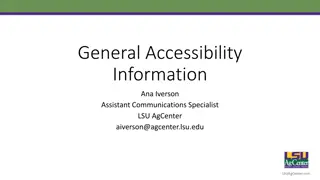Promoting Accessibility in Digital Content: Insights from University College London
The presentation highlights the European Accessibility Act (EAA) mandating private sector accessibility for products and services. Publishers face a significant task ahead as content must be inherently accessible. Taylor & Francis exemplifies proactive measures in promoting inclusivity through various initiatives. The importance of accessible formats like EPUB is emphasized for a user-friendly experience.
Uploaded on Sep 19, 2024 | 4 Views
Download Presentation

Please find below an Image/Link to download the presentation.
The content on the website is provided AS IS for your information and personal use only. It may not be sold, licensed, or shared on other websites without obtaining consent from the author.If you encounter any issues during the download, it is possible that the publisher has removed the file from their server.
You are allowed to download the files provided on this website for personal or commercial use, subject to the condition that they are used lawfully. All files are the property of their respective owners.
The content on the website is provided AS IS for your information and personal use only. It may not be sold, licensed, or shared on other websites without obtaining consent from the author.
E N D
Presentation Transcript
Accessibility and digital content Are we there yet? University College London, November 9 2022 Summary by Lindsay Jones, Libraries Accessibility Service
European Accessibility Act (EAA) 2019 Requires that private sector products and services be accessible Sort of the private sector equivalent to PSBAR Covers ebooks and services providing access to audiovisual media EAA applies to all publishers selling into EU from June 2025. Directive is vague and needs to be interpreted into law USA has similar legislation so UK likely to follow Publishers have a lot of work to do!
Taylor & Francis Stacy Scott (formerly at RNIB Bookshare) is now the Access Manager at T&F Accessibility is a stepping stone to inclusion. An accessible graph > a successful education > a job > economic stability > integration > happiness etc. The EAA will require publishers to do a lot of unscrambling the eggs (content must be born accessible to be truly inclusive retrofitting doesn t work and is costly). We will see a lot of progress.
What are they doing at T&F? Employees have a monthly platform to discuss accessibility all levels of the business Partner with RNIB Bookshare, US Bookshare and the AccessText Network. 160,000 T&F titles across these platforms in a variety of formats including electronic braille. When backlist titles are retrofitted these overwrite older versions in Bookshare etc. Converted 360 000 pdfs to epub on the Taylor & Francis journals platform. Also made content available in HTML and added a built-in audio option. Important to offer choice. Working on alt text programme measures books coming in to see if alt text has been applied. Then spot checking for quality.
T&F continued Encourage authors to supply alt text with manuscripts. 2300 books with author-supplied alt text and growing exponentially (some authors hesitant but largely positive). T&D provides guidance through author hub VIP mailbox designated mailbox for users to request accessible content with shortest possible turnaround (would this include asking them to add alt text?) Experimenting with back links to e.g. jump to and from a referenced graph and/or open figures in a new tab
Why is epub more accessible? Better hierarchical structure, reflows, works well with magnification, can be converted to other formats easily (My view what puts users off is 1)the lack of fixed pagination 2)the fact that most of our epub content is DRM-protected and users are forced to use ADE and 3)lack of familiarity. There may well be academics out there pushing PDFs as the version of record too) Recommends Thorium Reader for DRM-free epubs. Has a built-in screen reader
Ebook accessibility an academic library perspective Sue Smith, Learning Support, Leeds Beckett Students aren t aiming to get a degree in assistive technology so shouldn t have to be experts in the pros and cons of different formats and a full range of technology . Books need to work with their chosen set-up, whatever that is. Students are using a huge range of tools and versions of tools. May not be on latest version of software.
Issues with Read Online mode The platform may be accessible but not the content of the book May work with some tools and not others Some use a screenshot OCR tool (???) which slows things down (which platforms?) Built-in audio can be robotic Multiple formats some can be read aloud and others not.
Issues with Download mode Downloads can be tied to 3rdparty software (e.g. epubs and ADE) DRM restricts downloads to single chapter
Dream scenario Book opens in Edge and reads book aloud (seems a big fan of the Edge read aloud tool and uses it as a guide to whether other tools will work) Download not restricted Built-in tools are obvious, easy to find, easy to access support and save settings AND content supports same functions with independent assistive tech Magnification not restricted to small range All formats easy to navigate with table of contents Good honest guidance on pros and cons
What would help publishers/providers Make content accessible as well as platform Involve disabled people in testing Don t tie content to 3rdparty software Use image descriptions Use properly structured and OCRed PDFs Give downloadable files meaningful file names Prioritise replying to requests for alternate formats Don t assume accessibility is all about visually impaired users Put content on RNIB Bookshare (but longer term make it accessible at source)
What would help learning providers Test ebooks with disabled students Give feedback to suppliers Make info available on accessibility features Make accessibility part of procurement (see what SUPC is doing on this)
Penguin Random House perspective of a large publisher Simon Mellins, Ebook Technology Coordinator Huge task for large publisher to make all content accessible Lots of challenges mentioned, (but as participant pointed out, some big publishers are charging astronomical prices so ) Biggest challenges: creating accessible metadata (need to know more about this) and image descriptions
Image descriptions at scale Hard and costly Covering backlist is enormous challenge Options: 1. Using authors/editors Closest to content May not scale up Not all authors/editors keen or have time/skills 2. 3rdparty service Boom in these services They are specialist and good At what stage to add alt text? Before ebook conversion? 3. Typesetter/ebook conversion vendor More natural workflow But non specialist Problems with cultural, language or topic awareness Spot checking essential Could get overwhelmed if more publishers use them Publishing Accessibility Action Group looking at the real world challenges.
Publishing accessibly on a budget Charles Watkinson, University of Michigan Press Only publish 100 books per year so not like Penguin! Have own platform Fulcrum Embedded on OA movement but not yet fully OA
Umich Presss accessibility Adopted epub as primary ebook format (now adopting epub3) Created guidelines on visual resource descriptions, especially for humanities and soc sciences Describing Visual Resources Toolkit Describing Visual Resources for Accessibility in Arts & Humanities Publications Target for baseline accessibility: 2019. Then improving in three tiers. So for alt text: 1. Alt is not empty 2. Image has text equivalent 3. Image has effective quality description in line with toolkit Requiring alt text for new projects has been a struggle. Try to use authors, if not done by editorial assistants Users appreciate transparency above perfection
Accessibility technology: supporting staff Gavin Hendrick, Brickfield Laboratories Mostly talked about how to train staff to make the VLE more accessible Various training methods including putting context-sensitive help in Moodle Has embedded SensusAccess in Moodle, so student can select the format they want to read the item in
Organisational alt text: lessons in developing effective alt text for organisations Huw Alexander, textbox Digital Focus of talk on providing alt text services/consultancy Useful mnemonic for good alt text (P.I.C.T.U.R.E.) Precise Informative Consistent Thorough Useful Relevant Engaging
Huws top recommendation Create an organisational style guide for alt text (and sit it alongside your main style guide). Cover e.g.: Length How to deal with long descriptions Define style for popular image types (flowchart, barchart etc.) Punctuation and grammar Personal descriptions what to mention (gender, ethnicity etc.) Use of ordered lists University of Dundee has a great guide
What else helps? Set up a crowd-sourced organisational alt-text helpdesk so you can submit challenging images to the crowd Test your alt text get someone to try to draw the image from the description Get screen reader users to test Recognise and reward writing excellence
Open Access-ibility Really interesting! UNESCO definition of OA: free access to information and unrestricted use of electronic resources for everyone We are not living up to this as far as disabled people are concerned Most platforms pretty good, but content not so good, especially in institutional repositories (repository teams focus on compliance)
Principles around openness The F.A.I.R. principles are used to talk about openness with academics: Findable (is it on Google?) Accessible (in the sense of availability; does it work? can I open the file?) Interoperable (can I use it on different systems; will it live for a long time) Reusable (rights etc.) These are the closest we get to accessibility principles Why don t we as a sector define some key minimum standards for accessibility? (Could use P.O.U.R.)
Next steps TEF and REF could do more. How can we have gold standard research that is not accessible to all? Let s discuss as a community and find a party line. We could end up with minimum standards for us all to subscribe to. We could crowdsource guidance for academics and get sector-wide acceptance Have something for accessibility akin to funders asking for data management plans before giving money Come together! Get in touch if interested openscience@ucl.ac.uk. Look out for a working group and proposal paper aiming for the REF people?!
Making science-based social media accessible to blind people Justin Yarbrough, consultant/coach who is blind and uses a screen reader Social media democratises science Uses lots of pictures which is great for lay people but an issue for blind people Alt text is the solution. All major socials support alt text. Twitter has great setting you can enable which reminds you to add alt text Avoid long alt text causes problems for older versions of screen readers (lots of blind people on older versions) Imagine you are describing the picture over the phone
Misc You don t need to be a publisher to join PAAG Big Ten Academic Alliance (USA) has done systematic analysis of accessibility of aggregator platforms contact www.lib.umich.edu/users/ssrosen Why don t we crowdsource more (guides, testing etc)? Accessibility work done by publishers should transfer to aggregator platforms. May not work 100% of time but process is in place (T&F).























